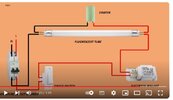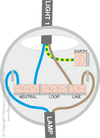I have a fluorescent light in the kitchen that I want to convert into a standard candescent light. Looking at wiring diagram below, there is only a live and neutral cable that feed the fluorescent ballast and bulb.
Can I disconnect the fluorescent fitting and wire up the new candescent bulb as shown in the photo, where there is no connection to the "loop" block in the celing rose?
So the live that went into the original ballast shown in the photo will go into the "line" block on the celing rose and the original neutral that went to the fluorescent bulb is going to be connected to the "neutral" block in the celing rose?
Can I disconnect the fluorescent fitting and wire up the new candescent bulb as shown in the photo, where there is no connection to the "loop" block in the celing rose?
So the live that went into the original ballast shown in the photo will go into the "line" block on the celing rose and the original neutral that went to the fluorescent bulb is going to be connected to the "neutral" block in the celing rose?




